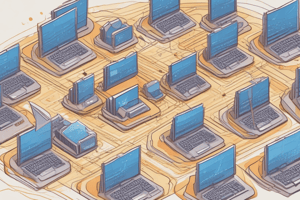Podcast
Questions and Answers
Which of the following is NOT an element in communication?
Which of the following is NOT an element in communication?
- Sender
- Receiver
- Channel/Medium
- Application (correct)
What is the primary role of intermediary network devices?
What is the primary role of intermediary network devices?
- Regenerate and retransmit data signals (correct)
- Provide end-user interfaces
- Originate messages
- Store end device data
In a client-server communication model, what is a client?
In a client-server communication model, what is a client?
- A device that stores data
- A device that provides information
- A device that generates data
- A device that sends requests for information (correct)
Which type of communication allows devices to function both as clients and servers?
Which type of communication allows devices to function both as clients and servers?
What mediums are commonly used in a computer network?
What mediums are commonly used in a computer network?
What must be established before starting a communication?
What must be established before starting a communication?
Which of the following correctly describes an end device?
Which of the following correctly describes an end device?
The term 'world without boundaries' in networking refers to:
The term 'world without boundaries' in networking refers to:
Which type of network is specifically recommended for very small networks?
Which type of network is specifically recommended for very small networks?
What is the primary characteristic of packet switching?
What is the primary characteristic of packet switching?
What type of network is designed to connect devices within a small geographic area, like a single building?
What type of network is designed to connect devices within a small geographic area, like a single building?
Which of the following statements best describes a broadcast network?
Which of the following statements best describes a broadcast network?
Which characteristic of network architecture focuses on minimizing disruption in the case of a failure?
Which characteristic of network architecture focuses on minimizing disruption in the case of a failure?
What does 'circuit switching' entail?
What does 'circuit switching' entail?
Which type of network primarily connects devices in a limited area such as a home or small office?
Which type of network primarily connects devices in a limited area such as a home or small office?
Which of the following best describes Quality of Service (QoS) in network architecture?
Which of the following best describes Quality of Service (QoS) in network architecture?
Flashcards are hidden until you start studying
Study Notes
Introduction to Networking
- Networks are essential for communication and connectivity in today's world.
- Networks connect people globally, creating communities and breaking boundaries.
Communication Elements
- Communication involves eight key elements: source, sender, message, channel, receiver, destination, understanding, and response.
- All elements are crucial for successful communication.
Understanding Communication
- Communication requires established rules and protocols.
- A communication protocol sets guidelines for data transmission and exchange.
Computer Networks
- Computer networks consist of devices, channels, and protocols.
- Devices include end devices and intermediary network devices.
- Channels encompass metal wires, glass fibers, and wireless transmissions.
- Protocols govern data exchange within the network.
End Devices
- End devices initiate or receive data.
- Data originates from an end device, traverses the network, and arrives at another end device.
Intermediary Network Devices
- Intermediary devices connect end devices.
- Examples include switches, wireless access points, routers, and firewalls.
- These devices manage data flow, including regenerating signals, maintaining information, and notifying devices of errors.
Types of Communication
- Client-server: Servers provide information to clients, who request it.
- Peer-to-peer: Devices act as both clients and servers, suitable for small networks.
Network Types by Size
- BAN (Body Area Networks): Small networks connecting devices within a person's body.
- PAN (Personal Area Networks): Networks connecting devices in a personal space.
- LAN (Local Area Networks): Networks connecting devices in a limited geographical area.
- MAN (Metropolitan Area Networks): Networks spanning a city or town.
- WAN (Wide Area Networks): Networks spanning large geographical areas, often using multiple LANs.
Network Types by Transmission Technology
- Broadcasting Networks: Send data simultaneously to multiple recipients.
- Unicast: Sending data to one recipient.
- Multicast: Sending data to a selected group of recipients.
- Broadcast: Sending data to all recipients.
- Switching Networks: Data travels from one point to another.
- Packet Switching: Data is divided into small packets, sent independently through different routes.
- Circuit Switching: A dedicated route is reserved for the entire transmission.
- Message Switching: Data is stored in intermediary devices before being forwarded, used for unreliable connections.
Reliable Networks
- Network architecture focuses on technologies supporting data movement.
- Key architectural characteristics include fault tolerance, scalability, quality of service (QoS), and security.
Fault Tolerance
- Fault tolerant networks limit the impact of failures, minimizing the number of affected devices.
Studying That Suits You
Use AI to generate personalized quizzes and flashcards to suit your learning preferences.




